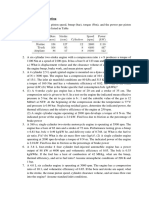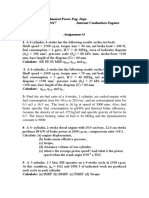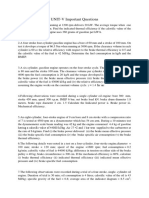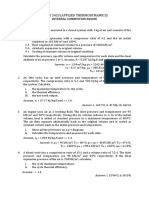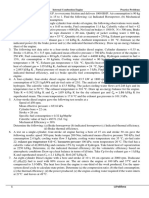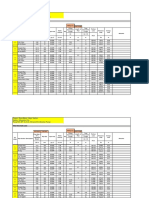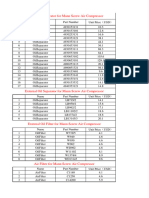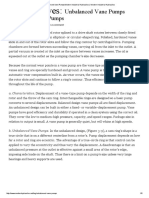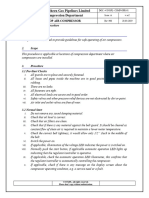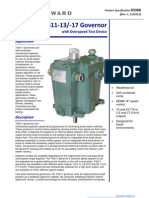I.C.
Engines (7ME5-11)
ASSIGNMENT-2
Testing and Performance
Note: 1. For Air, use the following values for the given parameters, if not provided in the question,
Cp=1.005 kJ /kg K, Cv=0.718 kJ/kg K, R=0.287 kJ/kg K and γ=1.4
Q.1 The air flow to a four cylinder four stroke petrol engine is measured by means of a 7.5 cm diameter
sharp-edged orifice, Cd = 0.6. During a test on the engine following data were recorded. Bore = 11 cm,
stroke = 13 cm, engine speed = 2250 rev/min, brake power = 36 kW fuel consumption = 10.5 kg/h,
calorific value of fuel = 42,000 kJ/kg., pressure drop across the orifice = 4.1 cm of water. Atmospheric
temperature and pressure are 15°C and 1.013 bar. Calculate: (a) Thermal efficiency on b.p. basis (b)
Brake mean effective pressure. (c) Volumetric efficiency based on free air conditions.
Q.2 A test on a single cylinder, four stroke oil engine having bore 18 cm and stroke 36 cm yielded the
following results; speed 285 rev/min; brake torque, 393 Nm; indicated m.e.p., 7.2 bar; fuel
consumption, 3.5 kg/hr; cooling water flow, 4.5 kg/min; cooling water temperature rise 36°C; air-fuel
ratio by mass, 25; exhaust gas temperature, 415°C; barometric pressure, 1.013 bar; room temperature
21°C The fuel has a calorific value of 45200 kJ/kg and contains 15% by mass of hydrogen. Determine
(a) the indicated thermal efficiency, (b) the volumetric efficiency based on atmospheric condition
Draw up a heat balance in terms of kJ/min explaining clearly the content of such term. Take R = 0.287
kJ/kg K, Cv for thy exhaust gases = 1.005 kJ/kg K and for superheated steam Cp = 2.05 kJ/kg K
Q.3 A test on a single-cylinder, four-stroke oil engine having a bore of 15 cm and stroke 30 cm gave
the following results: speed 300 rpm; brake torque 200 Nm; indicated mean effective pressure 7 bar;
fuel consumption 2.4 kg/h; cooling water flow 5 kg/min; cooling water temperature rise 35 °C; air-fuel
ratio 22; exhaust gas temperature 410 °C; barometer pressure 1 bar; room temperature 20 °C. The fuel
has a calorific value of 42 MJ/kg and contains 15% by weight of hydrogen. Take latent heat of
vaporization as 2250 kJ/kg. Determine, (i) the indicated thermal efficiency (ii) the volumetric efficiency
based on atmospheric conditions Draw up a heat balance in terms of kJ/min. Take Cp for dry exhaust
gas = 1 kJ/kg K and superheated steam Cp = 2.1 kJ/kg K; R=0.287 kJ/kg K.
Q.4 The power of a six-cylinder, four-stroke, direct injection oil engine is absorbed by a water brake
for which the law is b.p. = WN/20,000, where W = brake load in newton and N = speed in rev/min. The
air consumption was measured by an air-box sharp-edged orifice system. The following readings were
obtained:
Bore = 95 mm, Stroke = 120 mm, Speed = 2400 rev/min , Brake load = 550 newton, Ambient pressure
= 750 mm of Hg, Manometric head over orifice 14.5 cms of Hg
C/H ratio by mass in fuel = 83/17, Orifice diameter = 30 mm, Orifice coefficient of discharge = 0.6,
Fuel density = 0.831 Time to use 100 cc fuel = 19.3 s Ambient temperature = 25°C Calculate (a) the
brake mean effective pressure (b) the torque in Nm, (c) the brake specific fuel consumption, (d) the
percentage excess air, and (e) the volumetric efficiency.
Q.5 A four stroke cycle petrol engine has six single-acting cylinders of 7.5 cm bore and 9 cm stroke.
The engine is coupled to a brake having a torque am: radius of 38 cm. At 3300 rev/min, with all cylinders
operating the net brake load is 324 N. When each cylinder in turn is rendered inoperative, the average
net brake load produced at the same speed by the remaining five cylinders is 245 N. Estimate the
indicated mean effective pressure of engine. With all cylinders operating the fuel consumption is 0.3
kg/min; fuel calorific value 42000 kJ /kg; the jacket water flow rate and temperature rise are 65 kg/min
and 12°C. On test, the engine is enclosed in a thermally and acoustically insulated box, through which
the output drive, water, fuel, air and exhaust connections pass. Ventilating air blown up through the box
�at the rate of 14 kg/min enters at 10°C and leaves at 55°C. Draw up a heat account of the engine, stating
the items as a percentage of the fuel.
Q.6 A Morse-test on a turbo-charged, 12 cylinder, 2 stroke compression-ignition oil engine of bore 38
cm and stroke 50 cm gave the following readings.
Speed=200 rev/min.
Condition Brake load (N) Condition Brake load (N)
All firing 2000 No. 7 out 1800
No. 1 out 1795 No. 8 out 1824
No. 2 out 1814 No. 9 out 1785
No. 3 out 1814 No. 10 out 1804
No. 4 out 1795 No. 11 out 1814
No. 5 out 1804 No. 12 out 1795
No. 6 out 1819 All firing 2020
The law of break is b.p. = WN/180 kW where W = load in Newton N = rev/min
Calculate the brake mean effective pressure in bar and mechanical efficiency with all cylinders firing.
Carburettor
Q.7 A simple jet carburettor has to supply 5 kg of air per minute. The air is at pressure of 1.103 bar and
at a temperature 27°C. Calculate the throat diameter of the choke for air flow velocity of 90 m/s. Take
velocity coefficient to be 0.8. Assume isentropic flow. Assume the flow to be compressible.
Q.8 A single jet Carburettor is to supply 6 kg/min of air and 0.4 kg/min of petrol of specific gravity
0.75. The air is initially at 1.013 bar and 27°C. Calculate the throat diameter of the choke for flow
velocity of 92 m/s. Velocity coefficient=0.8. If the pressure drop across the fuel metering is 0.75 of that
at the choke, calculate orifice diameter assuming Cd=0.60.
Q.9 The four stroke engine of Hindustan Ambassador has capacity of 1489 cc. It develops maximum
power at 4200 r.p.m. The volumetric efficiency at this speed is 70% and the air-fuel ratio 13: 1. At peak
power the theoretical air speed at the choke is 90 m/s. The coefficient of discharge for the venturi is
0.85 and that of the main petrol jet is 0.66. An allowance should be made for the emulsion tube, the
diameter of which can be taken as 1/2.5 of the choke diameter. The petrol surface is 6 mm below the
choke at this engine condition. Calculate the sizes of a suitable choke and main jet. The specific gravity
of petrol is 0.74 and the atmospheric pressure 1.013 bar and temperature 27°C.
Q.10 The venturi of a simple carburettor has a throat diameter of 20 mm and the coefficient of air flow
is 0.85. The fuel orifice has a diameter of 1.25 mm and the coefficient of fuel flow is 0.66. The petrol
surface is 5 mm below the throat. Find (a) the air-fuel ratio for a pressure drop of 0.07 bar when the
nozzle lip is neglected ; (b) the air-fuel ratio when the nozzle lip is taken into account ; (c) the minimum
velocity of air or critical air velocity required to start the fuel flow when nozzle lip is provided. Take
density of air and fuel as 1.2 and 750 kg/m3 respectively.

